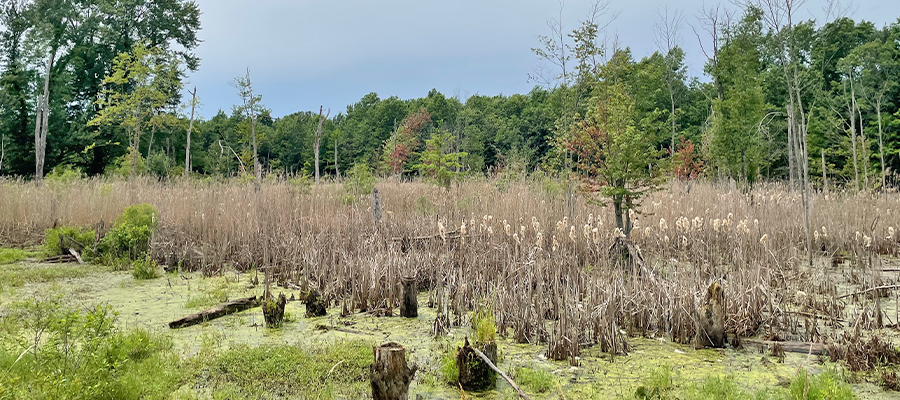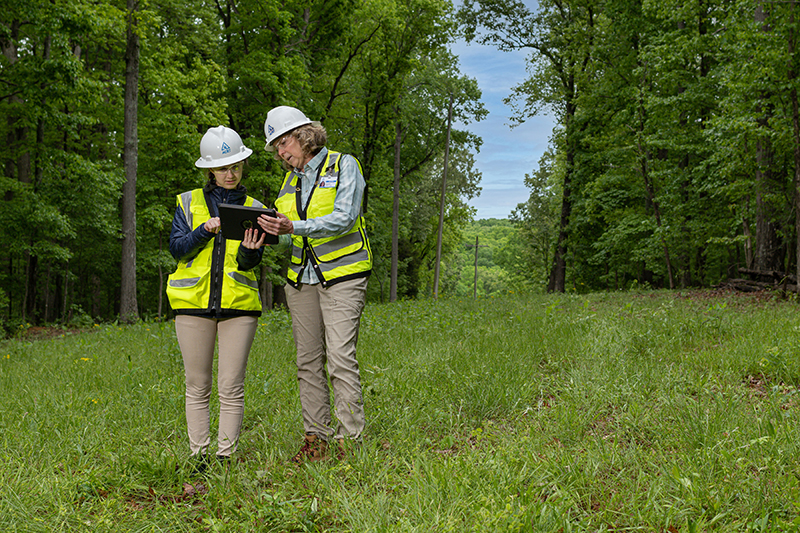- Vegetation Management Services
- Industries
- In Your Neighborhood
- About
- Careers
- Webinars
- Articles
Restorative Vegetation Management Legal Considerations

Restorative Vegetation Management Legal Considerations
By Michael Marefka, restoration ecologist and vegetation services operations manager, EnviroScience
Restorative vegetation management is an ecological restoration strategy intended to conserve, improve, and reintroduce habitat to natural systems impaired by human activity. Natural systems range in size and complexity, from small, channelized urban streams to preserved glacial fens and bogs. Each system presents unique restoration challenges, whether due to terrain or the presence of rare and endangered species, that requires expert planning, execution, and monitoring. Furthermore, protected areas and wildlife habitats require a holistic understanding of existing site conditions, and how those conditions influence system-level and species-level ecological function.
There is no one-size-fits-all approach to restorative vegetation management, especially when dealing with semi-intact natural systems that require immediate restorative intervention while simultaneously providing critical habitat to native species, both endangered and non-endangered.
Here, “challenge” is an umbrella term for a constellation of problems facing stakeholders involved in the restorative process. Vegetation management stakeholders include but are not limited to regulatory agencies, land conservancies, governmental natural resource organizations, vegetation management vendors, concerned neighbors, and wildlife. The ever-shifting landscape of challenges is a result of navigating the legal framework governing restorative vegetation management activities, manufacturing stakeholder consensus, defining and achieving project objectives with budgetary restraints, and identifying, through expert analysis, the ecological complexities of impaired natural systems.

Regulatory Compliance Reference Guide
Ensure your program meets critical requirements with this free guide.
Restorative vegetation management is disruptive. The success of mechanical, chemical, and biological methodologies of control is measured by the impact, removal, and permanent elimination of target species. A main challenge of managing target species near or within protected areas and wildlife habitats is preventing collateral damage. Non-target species, also known as desirable species, are often interspersed within an impaired natural system. The ratio of target to non-target interspersal is a major factor in the degree of challenge.
In the context of protected areas, wildlife habitats, and endangered species, restorative vegetation management compliance can be understood as an adherence to the system of rules and regulations designed to protect natural resources from harm. Harm reduction needs to be implemented both for invasive vegetation control and native vegetation installation, the two essential phases of restorative vegetation management.
For invasive vegetation management, compliance depends on control methodology (i.e., mechanical, chemical, biological), existing natural resource removal (i.e., crop tree release), and site assessment (i.e., presence of endangered species).
State and Federal laws govern chemical control application processes. Business licensing and individual commercial applicator certification requirements vary by State. In Ohio, for example, business licensing and applicator certification for herbicide use is regulated by the Ohio Department of Agriculture and required by all vegetation management vendors. The application of herbicide for commercial purposes without the appropriate licensing and certifications is not in compliance with laws governing restorative vegetation management. Furthermore, specific categories of certification, such as Aquatic Pests and Forest Pests, need securing, particularly when working in protected areas and wildlife habitats. Certification in these categories by commercial applicators displays an understanding of native and invasive vegetation, the label requirements of herbicides such as those approved for aquatic environments, and the ability to mitigate harm to non-target species by tailoring herbicide applications to specific site conditions.
Herbicide compliance is by far one of the most pressing challenges in managing vegetation near protected areas and wildlife habitats. Herbicide itself is a product regulated by the National Environmental Policy Act (NEPA), and only those evaluated and registered by the United States Environmental Protection Agency (USEPA) can be utilized for restorative vegetation management. Although navigating the labyrinth of state-specific herbicide rules and regulations is difficult in and of itself, the real challenge comes during the application process. Essential laws like the Migratory Bird Treaty Act (MBTA), which prohibits the harming of all native birds, nests, and eggs, put the onus on herbicide applicators to protect natural resources while performing services. This is why site assessments by experienced restoration professionals are imperative.
Restoration professionals understand and diagnose the system-level and species-level ecological functions at work on a given site. For example, identifying the presence of engendered species while also identifying their existing habitats, such as particular species of trees, shrubs, grasses, or forbs. Furthermore, they can define treatment timelines in compliance with governing laws, such as those that define nesting periods for endangered and non-endangered bird and bat species.
Vegetation management in protected areas and wildlife habitats involves a combination of mechanical and chemical control. Mechanical control components are meant to remove existing vegetation from a site, such as non-desirable trees or shrubs. This can pose a challenge for remaining in compliance, given that even non-desirable vegetative species can provide temporary habitat to endangered and non-endangered bird and bat species.
Assessment of nest timelines is crucial for the timely and successful execution of vegetation management services. Timelines for disturbance, set by the Division of Wildlife, often dictate budgetary and capacity restraints and require creative planning solutions to ensure project objectives are met while also protecting vulnerable wildlife populations. Assessments inform restorative vegetation services, and in the context of compliance with governing laws, they ensure treatments mitigate risk.
The main challenges of managing vegetation near protected areas and wildlife habitats often come down to balancing project objectives, limitations, and the interests of existing natural resources on a given site. Governing laws, such National Environmental Policy Act (NEPA) and the Migratory Bird Treaty Act (MBTA), provide the framework for protecting the latter. This framework should inform the project objectives and limitations and provide a realistic scope of work for all stakeholders involved in the restorative vegetation management process.
Restorative vegetation management is crucial for utilities, which often operate in diverse ecological landscapes. For example, by establishing pollinator habitats and raptor nesting programs, utilities can enhance biodiversity and mitigate vegetation management challenges. These initiatives support crucial species, naturally control pest populations, and demonstrate a commitment to environmental stewardship. This balance of operational needs with ecological preservation ensures compliance with regulations like NEPA and the MBTA, contributing positively to both the environment and utility operations.
This article was originally published in the 2024 September/October edition of the UAA Newsline.
Related Articles

Servant Leadership in Utility Vegetation Management By C. Troy Ross, President, ACRT and ACRT Pacific On a chilly Monday morning, a utility vegetation management crew gathers for their weekly briefing. Instead of launching into instructions, their supervisor begins by asking each team member how they’re doing. One mentions a child’s illness, another shares excitement about[...]
Read More
Turning Vegetation Waste into Opportunity By Aana Agrawal, Sustainability and Resilience Manager, EnviroScience The utility vegetation management (UVM) sector plays a crucial role in ensuring the smooth transmission of power across regions and cities by keeping plant growth under control within the vicinity of transmission and distribution lines. However, unrefined vegetation maintenance practices often focus[...]
Read More
Reflections from Will Nutter Silver Shield Award Recipients By Bob Urban, Senior Manager, ACRT Services In an industry where the stakes are high and every decision can have life-altering consequences, leadership in utility arboriculture isn’t just a managerial function; it’s a calling. Nowhere is this more evident than in the recipients of the Will Nutter[...]
Read More
The Electric Butterfly: Reconnecting with Nature on the Edges By Ryan Meccage, Business Development Manager, ACRT Services In an age dominated by smartphones, constant connectivity, and algorithm-driven content, we’ve never been more digitally immersed. Yet somehow, we’ve also never felt so far removed from the natural world beneath our feet. The urge to step away[...]
Read MoreRecent Posts
- Alex Fields Awarded ACRT Safety Challenge Coin 20th Nov 2025
- Servant Leadership in Utility Vegetation Management 12th Nov 2025
- ACRT Honors Our Veterans 10th Nov 2025
- Anna Davis Awarded Safety Challenge Coin 04th Nov 2025
- ACRT Senior Consulting Utility Forester Recognized as Safety Superstar 15th Oct 2025
Categories
The Leader In Vegetation Management
We are all about people, and we put safety first. Ready to work with our well-trained team?